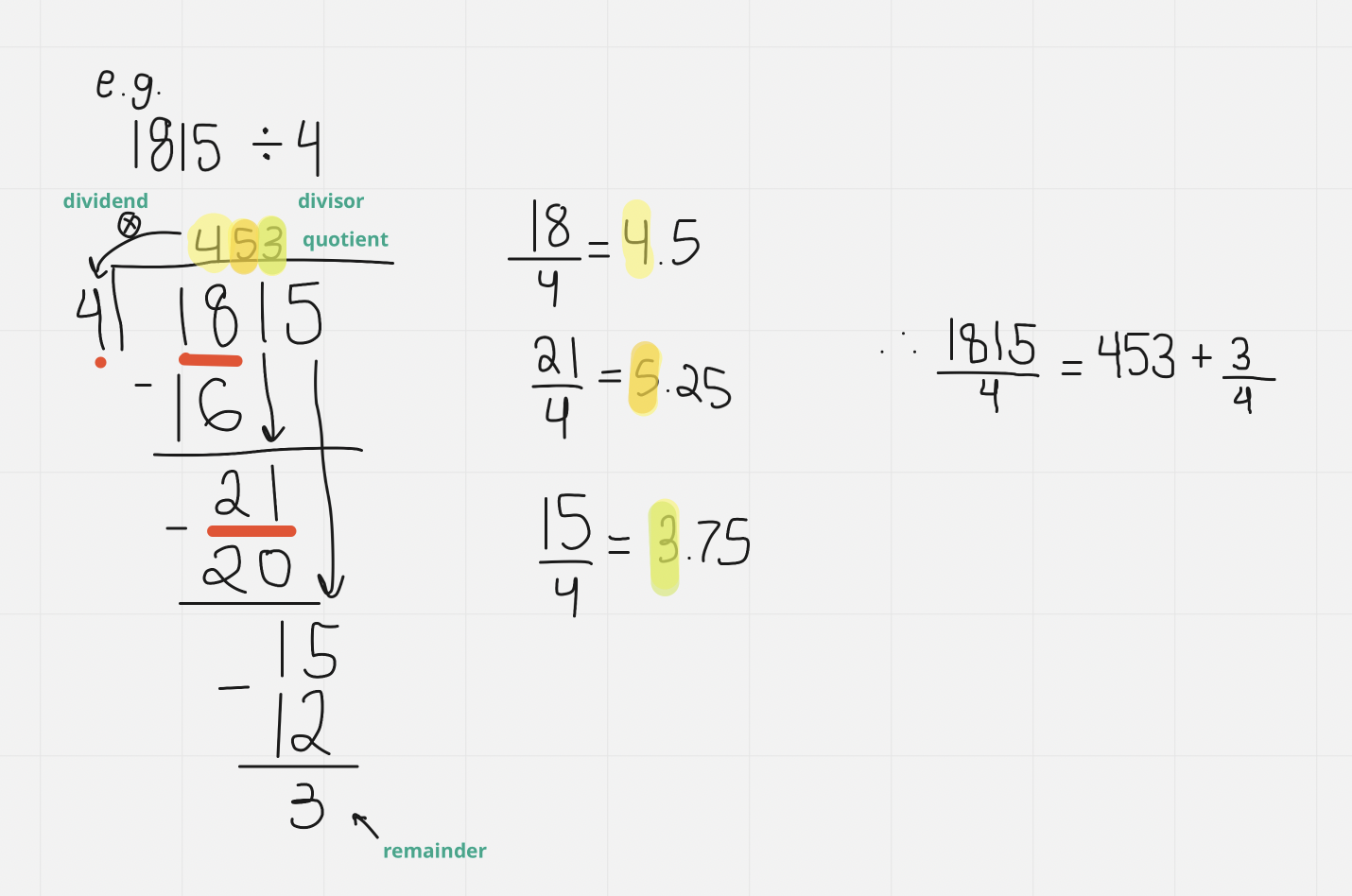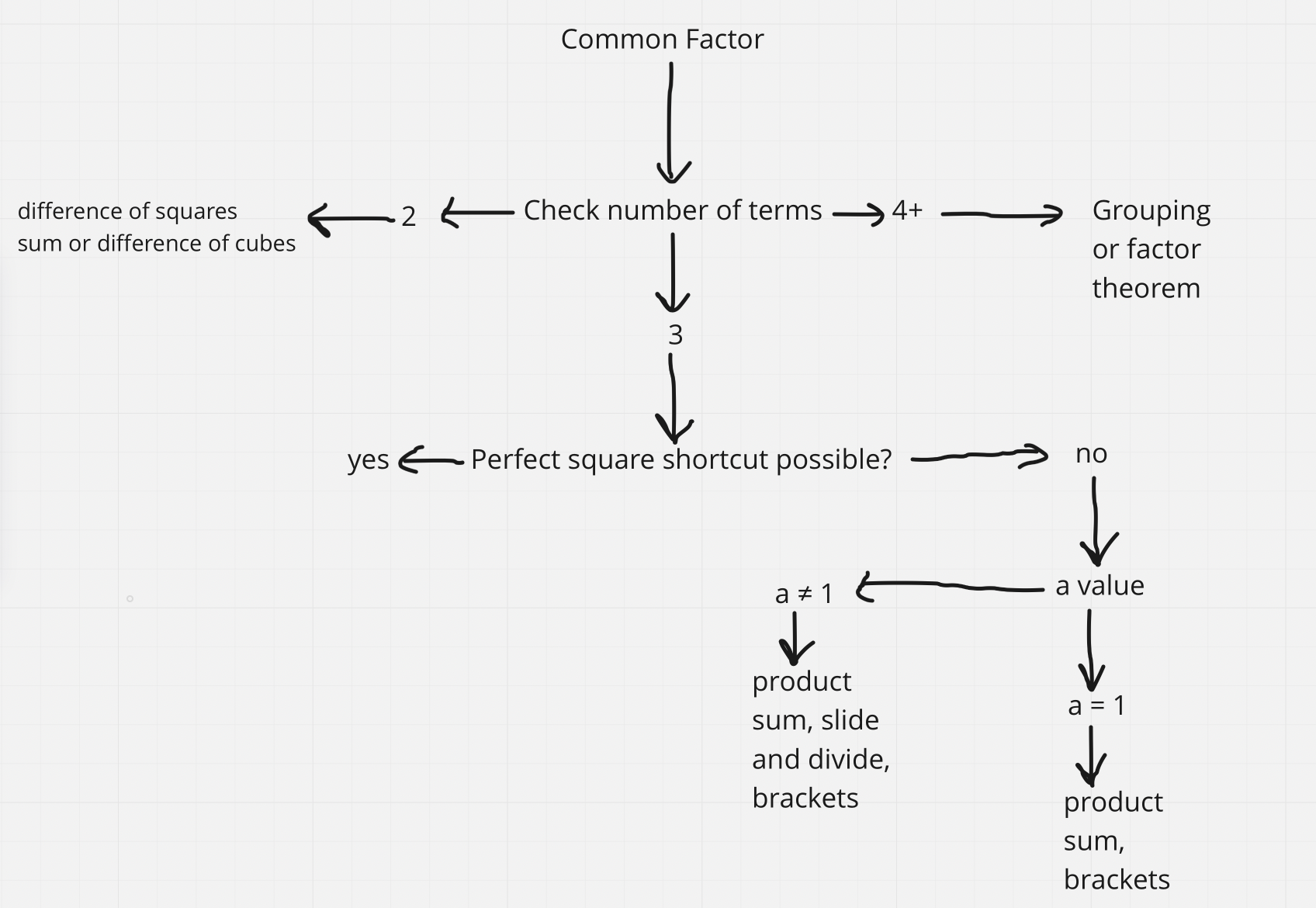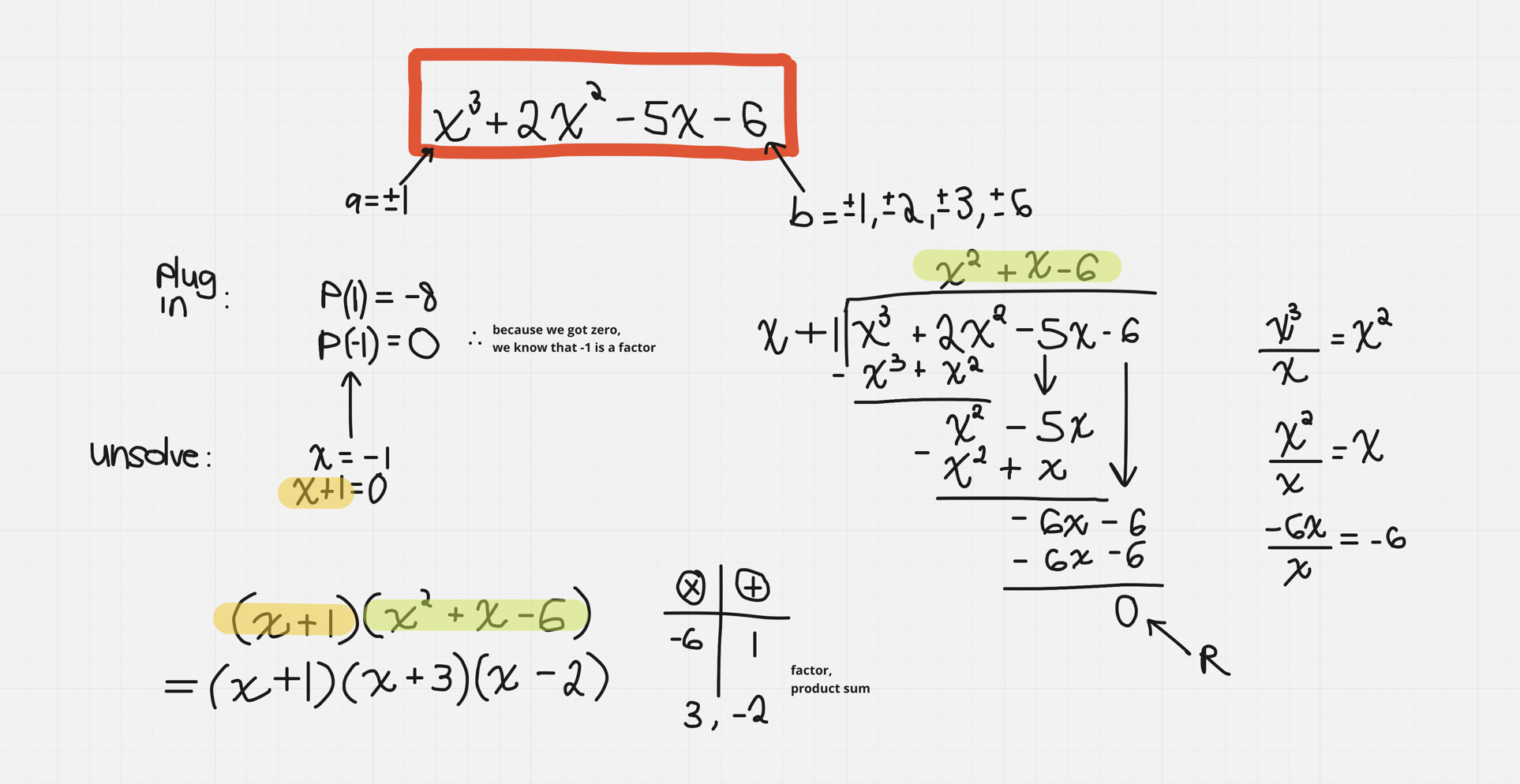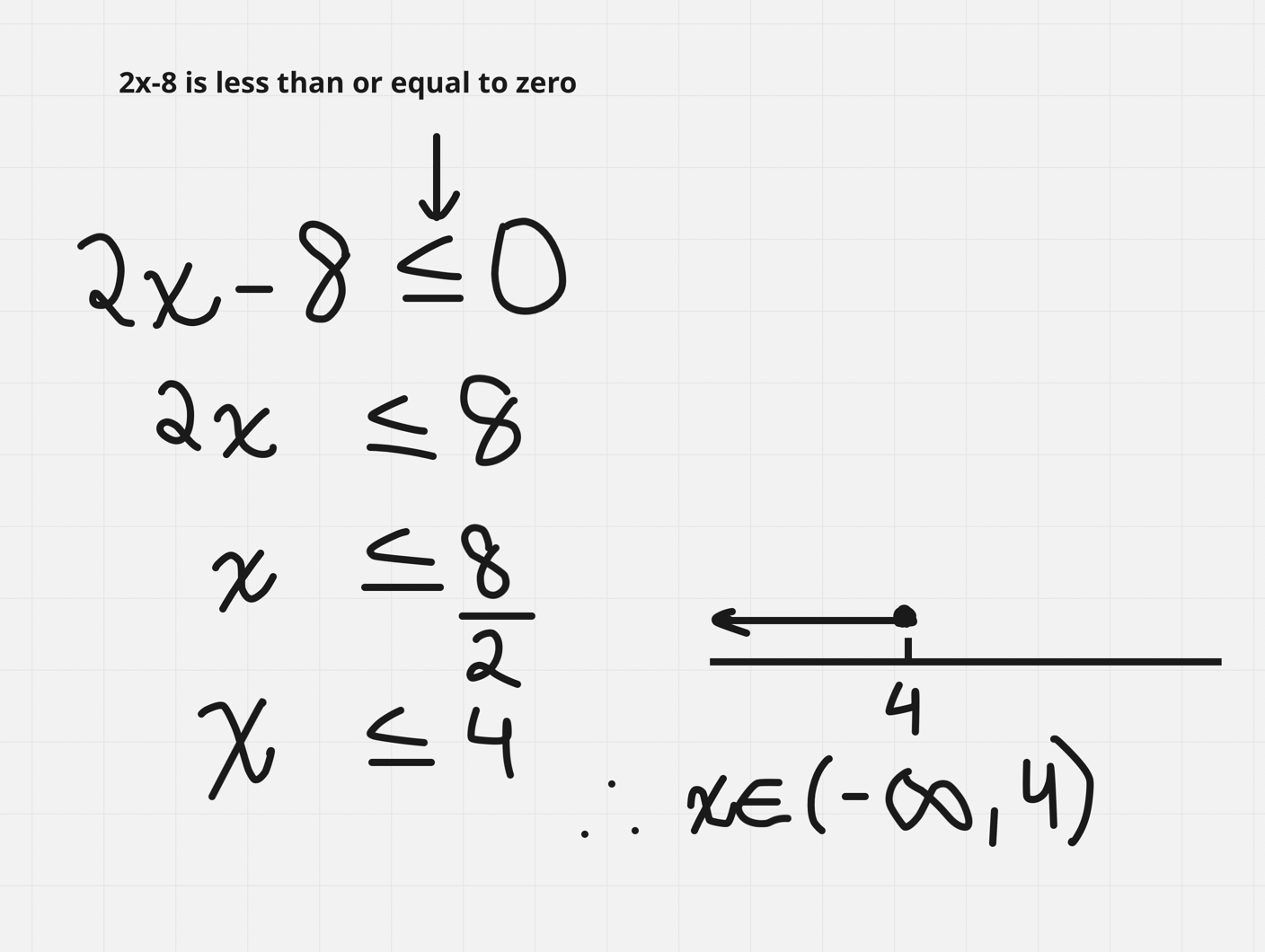
12-02: Working with Polynomials
Long Division
We can divide polynomials by using long division
Restrict the divisor - stating restrictions, make the divisor = 0 and solve
The Process of Long Division
Divide
Multiply
Subtract
Bring down
Non-polynomial long division example:

Quotient form

Check, clear fractions

Remainder Theorem
Allows for us to determine the remainder without doing long division
When a polynomial function P(x) is divided by (x-b)→ P(b) = R
When a polynomial P(x) is divided by (ax-b) → P(b/a) = R
Essentially, when you are dividing by variable added or subtracted with something, then you move it over and solve (because it originally must equal zero) and once you plug whatever you have just solved for into the equation, you will get the remainder
If x has a coefficient, then it becomes the denominator as you must divide it off to isolate x
Types of factoring
Taking out a common factor
Always do this first
Factoring Formulas
a² + 2ab + b² = (a+b)²
a² - 2ab + b² = (a-b)²
a² - b² = (a+b)(a-b)
a³ - b³ = (a-b)(a²+ab+b²)
a³ + b³ = (a+b)(a² - ab + b²)

Factor Theorem
Factor theorem states that…
x-b is a factor of a polynomial p(x) if and only if → p(b)=0
ax-b is a factor of a polynomial p(x) if and only if → p(b/a) = 0
Integral Zero Theorem
If x-b is a factor of polynomial p(x) with leading coefficient 1 and remaining coefficients that are integers then…
b is a factor of the constant
e.g.

Rational Zero Theorem
If polynomial p(x) has integer coefficients and x = b/a is a rational zero of p(x), then….
b is a factor of the constant
a is a factor of the LC
ax-b is a factor
Possible factors (test values) are any combination of ± b/a
Steps to Solving These Types of Problems
Find factors of a (LC) and b (Constant), both positive and negative (±)
Test p(b/a) until we get zero as a result of plugging (b/a) into the p(x) original equation → this is a factor, and we need to change it into an “unsolved” equation (e.g. x=1 would be (x-1) if you unsolved it, and thus your factor)
Divide by our factor using long division or synthetic division, you must get a remainder of 0
Take the factor found in step (2) and the quotient found in step (3) and smoosh them together
Factor fully from both brackets, and solve if needed
e.g.

Finding the Real Roots
The real roots of a polynomial equation can be found by setting the equation to zero, y=0
If the polynomial is factorable, the roots can be determined by factoring first fully and then setting each individual factor bracket to zero
Factor
Solve each root
Families of Polynomial Functions
Family: a group of functions with common characteristics (e.g. same x intercepts could be a common characteristic)
An Equation for the Family of Polynomial Functions with Zeros a₁, a₂, a₃…. aₙ
f(x) = a(x-a₁)(x-a₂)(x-a₃)…(x-aₙ)
a is different for each member of the family
The equation for a family can be determined from the zeros (x int) and a specific member of the family can be determined if given a specific point on the function
Sub in (x,y) to find a, must know a point on the curve’s coordinates in order to do so
Solving Inequalities
Sometimes there is a range of answers
Polynomial inequality: when the equal sign (=) is replaced with an inequality
, <, ≥, ≤ are all inequalities
Solving with Inequalities
Isolate for x
Treat the inequality almost like an equal sign
e.g.

The difference between = and an inequality: If we multiply or divide by a negative number in an inequality, we must flip or reverse the inequality
e.g.

Interval Tables
Always use circle brackets
Factor
Solve the brackets
Draw a number line to identify the intervals
Create a chart
Place intervals in the chart as columns
Place factors in the chart as rows
Place a final function sign row at the bottom
Pick a random number in between the intervals (not including the written numbers as those aren’t included, we used circle brackets) and substitute it into the variable in each factor row put in → write the sign of the number that you get
Determine the final sign by multiplying all of the signs down to get the overall functions sign
2 negatives make a positive, 2 positives make a positive, a mix of negative and positive makes a negative
Write your final X E statement based on what your looking for, and remember to put U in between intervals if there is more than one
12-02: Working with Polynomials
Long Division
We can divide polynomials by using long division
Restrict the divisor - stating restrictions, make the divisor = 0 and solve
The Process of Long Division
Divide
Multiply
Subtract
Bring down
Non-polynomial long division example:

Quotient form

Check, clear fractions

Remainder Theorem
Allows for us to determine the remainder without doing long division
When a polynomial function P(x) is divided by (x-b)→ P(b) = R
When a polynomial P(x) is divided by (ax-b) → P(b/a) = R
Essentially, when you are dividing by variable added or subtracted with something, then you move it over and solve (because it originally must equal zero) and once you plug whatever you have just solved for into the equation, you will get the remainder
If x has a coefficient, then it becomes the denominator as you must divide it off to isolate x
Types of factoring
Taking out a common factor
Always do this first
Factoring Formulas
a² + 2ab + b² = (a+b)²
a² - 2ab + b² = (a-b)²
a² - b² = (a+b)(a-b)
a³ - b³ = (a-b)(a²+ab+b²)
a³ + b³ = (a+b)(a² - ab + b²)

Factor Theorem
Factor theorem states that…
x-b is a factor of a polynomial p(x) if and only if → p(b)=0
ax-b is a factor of a polynomial p(x) if and only if → p(b/a) = 0
Integral Zero Theorem
If x-b is a factor of polynomial p(x) with leading coefficient 1 and remaining coefficients that are integers then…
b is a factor of the constant
e.g.

Rational Zero Theorem
If polynomial p(x) has integer coefficients and x = b/a is a rational zero of p(x), then….
b is a factor of the constant
a is a factor of the LC
ax-b is a factor
Possible factors (test values) are any combination of ± b/a
Steps to Solving These Types of Problems
Find factors of a (LC) and b (Constant), both positive and negative (±)
Test p(b/a) until we get zero as a result of plugging (b/a) into the p(x) original equation → this is a factor, and we need to change it into an “unsolved” equation (e.g. x=1 would be (x-1) if you unsolved it, and thus your factor)
Divide by our factor using long division or synthetic division, you must get a remainder of 0
Take the factor found in step (2) and the quotient found in step (3) and smoosh them together
Factor fully from both brackets, and solve if needed
e.g.

Finding the Real Roots
The real roots of a polynomial equation can be found by setting the equation to zero, y=0
If the polynomial is factorable, the roots can be determined by factoring first fully and then setting each individual factor bracket to zero
Factor
Solve each root
Families of Polynomial Functions
Family: a group of functions with common characteristics (e.g. same x intercepts could be a common characteristic)
An Equation for the Family of Polynomial Functions with Zeros a₁, a₂, a₃…. aₙ
f(x) = a(x-a₁)(x-a₂)(x-a₃)…(x-aₙ)
a is different for each member of the family
The equation for a family can be determined from the zeros (x int) and a specific member of the family can be determined if given a specific point on the function
Sub in (x,y) to find a, must know a point on the curve’s coordinates in order to do so
Solving Inequalities
Sometimes there is a range of answers
Polynomial inequality: when the equal sign (=) is replaced with an inequality
, <, ≥, ≤ are all inequalities
Solving with Inequalities
Isolate for x
Treat the inequality almost like an equal sign
e.g.

The difference between = and an inequality: If we multiply or divide by a negative number in an inequality, we must flip or reverse the inequality
e.g.

Interval Tables
Always use circle brackets
Factor
Solve the brackets
Draw a number line to identify the intervals
Create a chart
Place intervals in the chart as columns
Place factors in the chart as rows
Place a final function sign row at the bottom
Pick a random number in between the intervals (not including the written numbers as those aren’t included, we used circle brackets) and substitute it into the variable in each factor row put in → write the sign of the number that you get
Determine the final sign by multiplying all of the signs down to get the overall functions sign
2 negatives make a positive, 2 positives make a positive, a mix of negative and positive makes a negative
Write your final X E statement based on what your looking for, and remember to put U in between intervals if there is more than one
 Knowt
Knowt